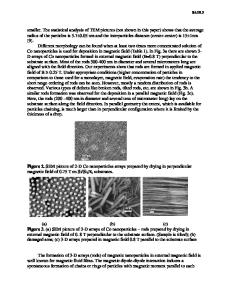Formation of Domain Structures in Ordering Processes of B 2 and D 0 3 Types
- PDF / 3,041,190 Bytes
- 6 Pages / 612 x 792 pts (letter) Page_size
- 13 Downloads / 309 Views
0979-HH11-53
Formation of Domain Structures in Ordering Processes of B2 and D03 Types Ryuichiro Oguma1, Syo Matsumura2, and Tetsuo Eguchi1 1 Applied Physics, Fukuoka University, Fukuoka, 814-0180, Japan 2 Applied Quantum Physics and Nuclear Engineering, Kyushu University, Fukuoka, 819-0395, Japan
ABSTRACT Time-dependent Ginzburg-Landau (TDGL) formulation has been developed for ordering processes of B2 and D03 types in binary alloy systems. In the formulation three order parameters are defined to describe the state of order. Equivalent variants of B2 and D03 structures are distinguished with the order parameters. The mean-field free energy is defined in a form of Landau type expansion with the order parameters and a composition parameter. Interfacial energies due to local variations of degrees of order and concentration are given with gradient square approximation. Kinetic equations are derived from the Ginzburg-Landau type potential to describe time-evolutions of the order parameters and the concentration. Two-dimensional numerical simulations were performed on the basis of the derived kinetic equations. The results reproduce well the formation of B2 and D03 ordered domains in the processes in an Fe3Al alloy.
INTRODUCTION Substitutional solid solutions of iron-rich Fe-Al binary alloy systems form ordered structures B2 and D03 on the basis of fundamental crystal lattice of bcc. The crystal structures of A2, B2, and D03 are considered in the unit cell consisting of eight bcc cells as shown in Fig. 1. In the A2 phase, element atoms of A and B occupy bcc lattice sites randomly. The B2 structure is formed by ordering reaction of A and B atoms between the first nearest neighbors. It consists of two sublattices of simple cubic type with different compositions. In the B2 phase two kinds of variants exist depending on which of the two sublattices A and B atoms preferably occupy. Antiphase boundaries (APBs) with displacement a/4 are formed where the two variants meet with each other. Here a is the lattice constant of the unit cell. If additional ordering between second nearest neighbor atoms takes place, the ordered state changes from B2 to D03. The stoichiometry of D03 is A3B in contrast to AB for B2. In the perfect D03 type order at A3B, B atoms form an fcc sublattice. The four kinds of variants are therefore defined in D03 depending on position of the fcc sublattice enriched with B atoms. The D03 ordered phase is partitioned into antiphase domains by APBs with a displacement of a/4 or a/2. In this study, we define a free energy function by a Landau expansion for B2 and D03 ordered phases, taking account of the symmetry relationships among the structures. The kinetic equations for ordering processes are derived in TDGL forms with the free energy function obtained, and are then applied to simulate the time evolution of B2 and/or D03 type ordering: A2 →D03 and B2 →A2+D03. The microstructural changes thus obtained are compared with the experimental results of TEM observation of an Fe-Al alloy.
Table 1. Atomic occupation p
Data Loading...











